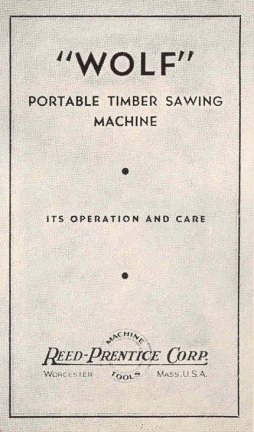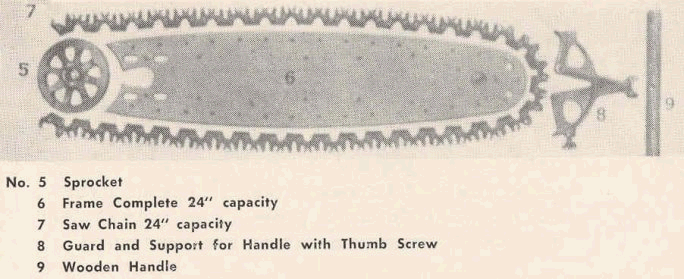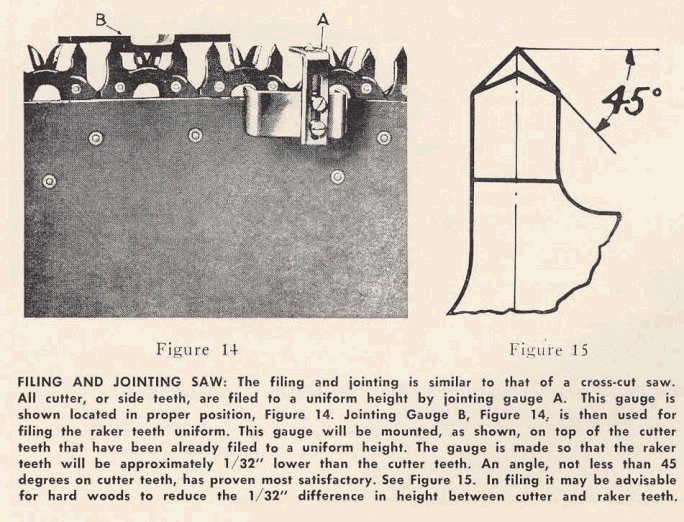Volume 2
In the October issue, Chain Saw Age published an article entitled “The Wolf Saga.” This largely historical story concerned the world’s first commercially successful portable chain saw. Charles Wolf who created it, and Jerome Wolf, his son who was associated with him in chain saw development. Re-examination of the subject and additional interviews with Jerome Wolf led to the conclusion that further and more detailed treatment would be both interesting and informative.
The introduction of the Wolf chain saw in 1920 and its continuing success for nearly a quarter-century thereafter maybe considered as the foundation of today’s $300,000,000 a year chain saw industry. In order to better understand the industry after 45 years, it is helpful to know more about its foundation. Specifically, to know more about Charles Wolf and the machine he created.
As mentioned in the previous article, patent and other records indicate that the individuals interested in chain saw development from 1858 to 1920 were not qualified to solve the problems involved. Consequently there was no significant progress made in such development during that period. Charles Wolf, as also mentioned, was both interested and qualified. He possessed an analytical and creative mind and his engineering experience was unusual and varied.
A thorough knowledge and understanding of the engineering fundamentals enabled him to develop and apply certain principles essential to the operational and commercial success of a chain sawing machine. Some of these principles were applied to the sawing mechanism, that is, the chain, sprocket and bar. Others involved the power unit and its balanced relationship with the sawing mechanism.
In the words of Jerome Wolf, “the application of these principles resulted in an efficient and economical chain sawing machine that was also reliable, substantial and well balanced. Obviously, it had to have all these attributes, otherwise it would not have succeeded initially and continued on decisively to defeat all competitive efforts for more than 20 years.
“These same principles are as essential today as they were then. In fact, since the Wolf era, manufacturers of chain saws and saw chain without knowing the origin, have used these principles with varying degree of effectiveness. The effective application of the principles has varied over the years in accordance with the ability of their engineers to recognize and utilize them.
“The development and application of essential principles for and to the Wolf machine was of primary and paramount importance. It was, however, only part of a formidable problem. Additionally, there were innumerable important details such as proportions, dimensions, tolerances and standards of material and workmanship for both the sawing mechanism and power unit. Prior to Wolf, there never had been a successful portable chain saw. Consequently, there were no guiding precedents in these and other respects as there are today. Without such precedents, it was understandably an especially difficult task to prepare and furnish to the manufacturer complete plans and specifications for the entire machine.
“The difficulties in getting the project started were compounded by the fact that, unlike today there was no precedent for a production system for this type of product. As a result an entire production system had to be devised for the manufacturer, which involved everything from a simple jig to an assembly line. Within a few months, despite all such problems, the Wolf machine was on the market with a quality of workmanship and material that is unexcelled today.”
Considerable interesting information for this article was obtained from copies of advertising and other literature published by the Reed-Prentice Corporation, manufacturer of the Wolf machine. The most informative source is the so-called maintenance manual. This was a 29 page booklet measuring 8-1/2 by 5-1/2 inches, (21.5 by 13.9 cm) printed on an excellent grade of glossy paper. The composition is reminiscent of the type of manual that was supplied only by the makers of the more expensive automobiles of the period.

WOLF OPERATION AND CARE MANUAL
The manual contains complete information regarding the operation and care of the Wolf machine. Reproductions of drawings illustrate features. Included are sharp, clear photographic reproductions of the various machine models and all component parts. Each photograph bears a number which corresponds with those in a descriptive list. Actually, the booklet is a combination instruction manual and catalogue. According to Jerome Wolf, it played a very important part in sales and service.
“During the Wolf era, there were no distributor-dealer outlets specifically for chain saws and related items such as the 25,000 to 30,000 that exist today. Only a handful of outlets were available to us. Some of these outlets were well established and competent industrial supply firms. Others stocked no parts and were otherwise unsatisfactory. As a result, the majority of our customers were entirely dependent upon the manual for service. The numbered photographs showed the various items so clearly that there was little chance of error in identifying parts. By means of the manual, customers located all over the world were able to service their machines by mail with little or no difficulty.”

BAR CHAIN AND SPROCKET
“Service, in this manner was especially easy for electric and pneumatic machine customers. For example, the A.C. electric motors operated for years without requiring repair and replacement parts. Pneumatic motors were also economical in this respect. Service for the more or less unsatisfactory gas-engine of the period, of course, was more difficult. However, a few of these were sold.
“This type of mail-order self-service may not have been the most desirable but it was effective. In fact, it was an invaluable necessity because there was no world wide chain saw distribution system as there is today. Furthermore it was not without advantages. Almost exclusively, the Wolf mail-order customers were established firms and governments instead of individuals. Consequently, a collection loss was rare. Sales commissions were more or less eliminated and those that were paid were unbelievably low. During the entire history of the business, such commissions averaged only 8% of the retail price.”
The manual contains instructions for filing the Wolf chain saw which are reproduced herein. The instructions consist of approximately 125 words, accompanied by two simple illustrations. Two inexpensive gauges and a flat file were required to carry out the instructions. The intriguing simplicity of the instructions provoked certain questions resulting in the following response by Mr. Wolf.
“The instructions were easy to carry out for two reasons. First, only the tops of the teeth were filed, therefore the filer could see what he was doing. Second, the filer had only one angle to file on both the cutters and raker teeth and only flat surfaces were involved in both cases. Cutters were restored to sharpness by stroking the file against the flat angular surface of the factory established bevel on each side of the cutter point. The raked teeth edges were easily sharpened by merely stroking the file against the factory established flat, angular surface on the top of the tooth.”

FILING AND JOINTING THE SAW
In interviewing Mr. Wolf, mention was made of the fact that a great deal of material has been written in publications and manuals about filing the present conventional chain. It was pointed out that in one manual the filing instructions consist of 3-1/2 pages, measuring 8-1/2 by 5-1/2 inches containing about 900 words accompanied by 9 illustrations. According to these instructions, accurate and correct filing requires 6 tools consisting of a round and a flat file, and 3 gauges for checking tooth angles. Mr. Wolf was asked to explain the contrast between this lengthy material and the brief, simple instructions for the old Wolf chain.
“Evidently, more knowledge and skill is required to file the conventional chain, otherwise, all such instructions and tools would be unnecessary. The conventional tooth design is different from that of the Wolf chain, consequently, a different filing procedure is required.
“In the conventional chain, the file is applied underneath the top plate of the tooth and the filer cannot see what he is doing. Furthermore, there are three critical angles in one tooth that must be skillfully and correctly filed simultaneously in one operation. The file must be held accurately in the prescribed position, otherwise, all three angles are adversely affected simultaneously, which impairs cutting efficiency.
“In the Wolf chain there was only one angle per tooth to file instead of three. Logically, it is easier to file one angle per tooth instead of three, especially, where the three have to be filed simultaneously in one operation.
“In filing the conventional chain, the filer must also maintain the correct relationship between depth gauges and teeth. Otherwise, cutting efficiency is again impaired and the chain links are cracked and/or severely damaged in other ways. The Wolf chain was designed so that no such damage occurred. The only result of improper filing was that the chain did not cut as fast as it should.” |